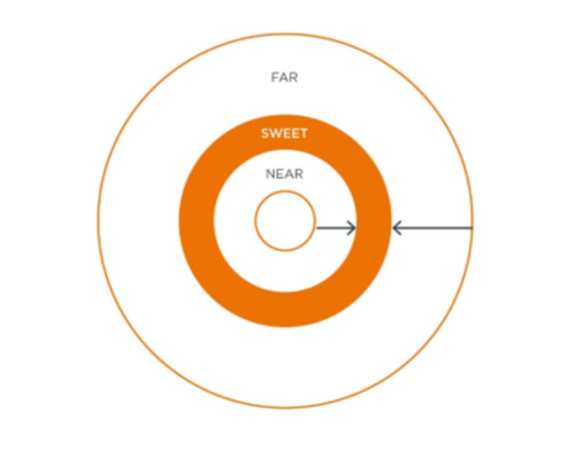How To Optimize Your Innovation Strategy by Making Your Idea a Sweet Idea
What’s the perfect New Year’s Resolution?
Hint: think re: innovation strategy
Well, if that wasn’t sufficient, here are two additional hints…
(1) It’s not only challenging but actually promises a significant change in your life;
(2) It’s not pie in the sky, but applicable to your daily life.
Let’s take a more practical approach…
If your goal is to get in shape, watching TV while standing is maybe not the most effective initiative. However, regular mountain climbing is probably a bit of a stretch if you are a fairly immobile city dweller.
This is the Near-Far-Sweet Idea Mapping Model as applied to your daily life.
Near – ideas that are pretty close to current practice. They are new, but probably not impactful enough to be worth your attention.
Far – exciting ideas, but not viable. Either the market is not ready to accept them, or you will not be able to implement them.
When optimizing your innovation strategy you want your ideas to be neither too close to home (“Near”) nor too challenging to be implementable (“Far”). You want your ideas to be new and exciting but at the same time realistic and useful. This is your Innovation Sweet Spot.
Learn How To Enhance Your Innovation Strategy By Making Your Ideas Sweet:
This all sounds pretty obvious and common sense. Surprisingly, the distinction is often overlooked, or at least not given systematic treatment. Categorizing the results of an ideation session or workshop into Near, Far and Sweet – as seen in the visual on the right – will give you an important indication as to the practicality of your ideas. It can also be a useful tool to improve the outcomes of your innovation strategies, by pushing some Nears and Fars into the Sweet Spot.
But before we share a quick guide to applying NFS to NPD, here are some thoughts of how it can serve as a practical tool to support the “Dual Innovation Approach” as defined by Ralph-Christian Ohr. Ohr cites research that shows that the Dual Innovation Approach is used by 70% of the most innovative companies:

[With Dual Innovation] innovation management follows a balanced portfolio approach. The entire innovation portfolio is divided into exploitation-oriented and exploration-oriented innovation initiatives, where the following characterizations hold:
- Exploitation-oriented initiatives are related to running the core business by executing and enhancing existing business models or technological capabilities. The primary direction of impact is valued capturing (commercialization). Examples: Product, service or process innovation, portfolio extension, innovation of selected business model components (e.g. channel or operations), market research.
- Exploration-oriented initiatives are related to developing future business by searching for the novel, and often disruptive, business models or technological capabilities. The primary direction of impact is value creation (configuration). Examples: Business model development, platform/ecosystem innovation, basic technology research & development, startup engagement, innovation intelligence.
(https://dual-innovation.net/a-model-for-dual-corporate-innovation-management/) Ralph-Christian Ohr
Ralph-Christian further introduces three playing fields of dual innovation:
- Optimize the Core (Optimization of existing business models and technologies)
- Reshape the Core (Transformation of existing business models and/or scaling up new business models/technologies)
- Create the New (Creation of new-to-the-company business models and Technologies)
(http://integrative-innovation.net/?p=1765) Ralph-Christian Ohr
Integrating Ideas
He then elaborates on the true challenge of dual innovation: neither developing extensions of the product/service portfolio within the existing business model, nor coming up with completely new ideas, but integrating new ideas into your existing innovation strategy:
When it comes to integration, most companies face huge problems. This is the space where two main activities need to be conducted to achieve business impact from innovation and to future-proof the existing business model:
- Validated breakthrough or even disruptive innovation concepts need to be scaled up for achieving business impact. If a company does not master Scaling-Up there is a high chance that all ideation will remain only innovation theatre.
- In the light of Digital Transformation, adapting the established core business models by innovating selected elements (e.g. platform strategies, x-as-a-service business models, bypassing the middle man or automatization of service processes) is mandatory. If a company does not master adaptation it risks to lose in Digital Transformation.
(http://integrative-innovation.net/?p=1765) Ralph-Christian Ohr
Ohr presents a challenge: strategic ideas ought to be transformed to have maximum impact – to be innovative enough but not too disruptive. Through the NFS model, the SIT (Systematic Inventive Thinking) methodology invites you to apply two principles that, together, cover both directions:
1. Qualitative Change. Very often, “near” ideas are generated by incrementally improving on existing offerings, making them “bigger, faster, better”, i.e a quantitative change. The QC principle calls you to observe the basic logic of your product or service but change a fundamental relationship in this logical structure. Example: don’t offer your product at a discount, but offer it for free, generating revenue by a totally different business model. This is easier said than done, of course, but using the right tools, it allows you to push Near ideas into the Sweet Spot.
2. Closed World. The second basic principle of SIT is rather counterintuitive: when innovating, try as much as possible to utilize only those elements that already exist in the system.

Instead of reaching out of the box, innovate inside the box. Instead of searching for new elements, find new angles and possibilities in the existing ones. By applying several tools under this principle, you will be able to pull in some Far ideas, turning wishful thinking into viable options and improve your innovation strategy
So, here’s a NY’s resolution that hopefully resides within your Sweet Spot: Map your new ideas on an NFS diagram, consider whether enough of them are in the Sweet Spot, and then push and pull those that are not to create exciting but viable options for development of your innovation strategy. Enjoy.
Want to keep learning? Check out what you can learn from an innovation facilitation session.


